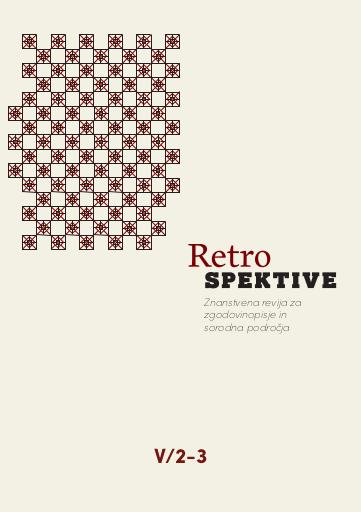/
Serijske publikacije
/
Retrospektive
Rapalska meja in njen vpliv na zgodovinski prostorski razvoj okolice: primer Žirovske kotline

Soavtor(ji):Peter Mikša (odg. ur.), Kornelija Ajlec (gl. ur.), Maja Vehar (drugo), Jure Bežan (teh. ur.)
Leto:2023
Založnik(i):Združenje za promocijo kulturne dediščine, raziskav in novih tehnologij- Retrospektive, Ljubljana
Jezik(i):slovenščina, angleščina
Vrst(e) gradiva:besedilo
Ključne besede:rapalska meja, vpliv vojaškega utrjevanja na razvoj prostora, militarizacija prostora, Rupnikova linija, občina Žiri, morfološki razvoj Žirov, the Rapallo border, the influence of military fortification on the development of space, the militarization of space, Rupnik’s line, the municipality of Žiri, the morphological development of Žiri
Avtorske pravice:

To delo avtorjev Peter Mikša, Alenka Fikfak, Janez P. Grom je ponujeno pod Creative Commons Priznanje avtorstva-Nekomercialno-Deljenje pod enakimi pogoji 4.0 Mednarodna
Datoteke (1)

Ime:Retrospektive_letnik5_st2-3.pdf
Velikost:1.30MB
Format:application/pdf
Stalna povezava:https://hdl.handle.net/11686/file37664
Opis
Vzpostavitev rapalske meje leta 1920 je zagotovila politično osnovo za izgradnjo obsežnih utrdbenih sistemov na italijanski in jugoslovanski strani. Medtem ko so Italijani vzdolž celotne državne kopenske meje zgradili 1851 kilometrov dolg obrambni sistem Alpski zid, so Jugoslovani ob jugoslovansko-italijanski meji zgradili približno 250 kilometrov dolgo »Rupnikovo« obrambno linijo. Raziskava je preverila vpliv na prostor, ki ga je imela vzpostavitev rapalske meje oziroma konkretneje utrdbenega sistema Rupnikove linije na morfološki razvoj naselja Žiri. Rezultati analiz kažejo na večplastnost pomenov in vplivov na razvoj prostora kot posledico delitve homogenega teritorija. Poleg očitnih negativnih učinkov na razvoj na tem teritoriju živečega prebivalstva je raziskava pokazala, da je vsiljena dinamika kot posledica utrjevanja vplivala na razvoj širšega prostora. Primerjani sta naselji Žiri in Idrija s ciljem vzpostavitve pregleda razvojnih razlik v zastavljenih časovnih intervalih. Ugotovljeni razvojni zagon je sledil – v Idriji na italijanski ter v Žireh na strani kraljevine Jugoslavije – različnim motivom in principom ter je v prostoru pustil še danes vidne, različne in izrazite vzorce grajenega prostora. Obravnavanim prostorom edinstvene situacije so podlaga za snovanje prihodnjega prostorskega razvoja, ki lahko na podlagi v raziskavi drugače ovrednotene dediščine in njenih vpliv na razvoj prostora ravno v tej dediščini najde motiv za unikatnost razvoja in s tem oblikovanjem izrazite identitete. Članek želi prikazati pomen in vrednost prostorskih implikacij dediščine rapalske meje s pomočjo zgodovinske kontekstualizacije in sodobne urbanistične teorije.
Metapodatki (12)
- identifikatorhttps://hdl.handle.net/11686/59047
- naslov
- Rapalska meja in njen vpliv na zgodovinski prostorski razvoj okolice: primer Žirovske kotline
- The Rapallo Border and its Influence on the Spatial Development: the Case of the Žiri Basin
- avtor
- Peter Mikša
- Alenka Fikfak
- Janez P. Grom
- soavtor
- Peter Mikša (odg. ur.)
- Kornelija Ajlec (gl. ur.)
- Maja Vehar (drugo)
- Jure Bežan (teh. ur.)
- predmet
- rapalska meja
- vpliv vojaškega utrjevanja na razvoj prostora
- militarizacija prostora
- Rupnikova linija
- občina Žiri
- morfološki razvoj Žirov
- the Rapallo border
- the influence of military fortification on the development of space
- the militarization of space
- Rupnik’s line
- the municipality of Žiri
- the morphological development of Žiri
- opis
- The establishment of the Rapallo border in 1920 provided the political basis for the construction of extensive fortification systems on the Italian and Yugoslav sides. While the Italians built the 1,851-kilometer-long Alpine Wall defense system along the entire country’s land border, the Yugoslavs built the approximately 250-kilometer-long “Rupnik” defense line along the Yugoslav-Italian border. The research examined the spatial impact that the establishment of the Rapallo border, or more specifically the fortification system of the Rupnikova Line, had on the morphological development of the Žiri settlement. The results of the analyses show the multifaceted meanings and influences on the development of space as a result of the division of a homogeneous territory. In addition to the obvious negative effects on the development of the population living in this territory, the research showed that the imposed dynamics as a result of consolidation influenced the development of the wider area. The settlements of Žiri and Idrija are compared with the aim of establishing an overview of development differences in set time intervals. The established development momentum followed - in Idrija on the Italian side and in Žiri on the side of the Kingdom of Yugoslavia - different motives and principles, and left visible, different and distinct patterns of built space in the area even today. The unique situation of the area under consideration is the basis for the design of future spatial development, which, based on the differently evaluated heritage in the research and its influence on the development of the space, can find a motive for the uniqueness of the development in this heritage, and thus the creation of an expressive identity. The article aims to illustrate the significance and value of the spatial implications of the heritage of the Rapallo border through historical contextualisation and contemporary urban theory.
- založnik
- Združenje za promocijo kulturne dediščine, raziskav in novih tehnologij- Retrospektive
- datum
- 2023
- 12. 01. 2023
- tip
- besedilo
- jezik
- Slovenščina
- Angleščina
- jeDelOd
- pravice
- licenca: ccByNcSa
